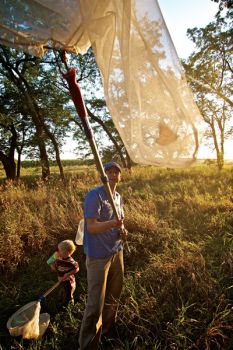The Gift of South Dakota
Subscriptions to South Dakota Magazine make great gifts!
Subscribe today — 1 year (6 issues) is just $29!
Mysterious Monarchs
MONARCH BUTTERFLIES ARE just a couple inches long, weigh less than an ounce and flutter through the air with wings as thin as tissue paper, but they may be the most intriguing creatures in South Dakota. When the blaze orange butterflies arrive in South Dakota this spring from their winter retreat in southern Mexico, they will have completed the final leg of a 2,500-mile journey to a place they’ve never seen.
The life cycle of monarchs is six to eight weeks, but the butterflies that hatch in South Dakota in August live an incredible six to eight months. When autumn arrives, they fly the entire 2,500 miles to the Oyamel fir forests, where they hibernate through the winter, often in the same trees as their ancestors. When they reawaken and fly north in the spring, they lay eggs, which dramatically shortens their lifespan. Soon, they die. The process repeats as the butterflies slowly progress northward. The monarchs that arrive here around Mother’s Day are the fourth generation descendants of those that departed last fall.
The migration and monarch life cycle have stumped scientists and butterfly watchers for decades. Why do monarchs that hatch in late summer live four times longer than others? How do they know to fly to southern Mexico every fall? In 1992 the University of Kansas launched Monarch Watch, a nationwide research program devoted to studying the mysterious monarchs. A popular research tool is butterfly tagging. Monarchs are netted and a tiny sticker with a code — no bigger than the nail on your pinky finger — is affixed to a wing. It doesn’t hinder flight, and scientists can track where the butterflies go and how long it take them to reach Mexico.
The Outdoor Campus was the first facility in South Dakota to tag butterflies. Thea Miller Ryan, the Outdoor Campus director, is an avid butterfly observer, though she was hesitant to include monarchs when the facility opened in 1994. “If you want to bring them in and raise them, and you take care of them, and I don’t ever have to look at them, you can do it,” Ryan remembers saying. “They brought them in and six hours later I was hooked. And I’ve never been able to get it out of my system. They are an incredible creature. There’s so much to learn about monarch butterflies.”
Today over 100,000 students and adults across the country obtain tags from Monarch Watch and apply them to monarchs passing through their yards. Every August, Jody Moats, of the Adams Nature Preserve near Elk Point, leads volunteers in butterfly tagging at Spirit Mound. Monarchs cluster by the dozens high in the branches of old hackberry trees. Their wings glow even brighter orange in the light of the sun setting beyond the mound. Children swoop nets twice their height through the trees, hoping to capture and tag the butterflies. Other tagging events are scheduled throughout South Dakota, including one at Palisades State Park near Garretson on Aug. 30.
Monarchs may seem abundant, but their numbers have slowly dwindled in recent years. They face a potentially life threatening challenge: habitat loss. In Mexico loggers are slowly decimating the fir forest, and on the Plains their food source is disappearing. Caterpillars that become monarchs will only eat milkweed, long the scourge of farmers. Thanks to pesticide resistant crops, milkweed has become easier to eradicate. That’s why Ryan and others encourage planting “monarch waystations,” patches of milkweed in yards and gardens that help the butterflies survive.
“People always think of the common milkweed in the ditches, the kind we all had to pull when we were kids,” Ryan says. “But there are a lot of different varieties of milkweed that grow in South Dakota, and you can get those at garden centers. They don’t look at all like common milkweed. They’re really pretty and they bloom in all different colors.”
Monarchs are beautiful to observe, but once you get to know them they become even more fascinating. After all, would you intentionally plant weeds in your garden for any other creature?
Editor’s Note: This story is revised from the March/April 2012 issue of South Dakota Magazine. To order a copy or to subscribe, call (800)456-5117.













Comments
We would love to chat: 605-691-1074
Wings up!!